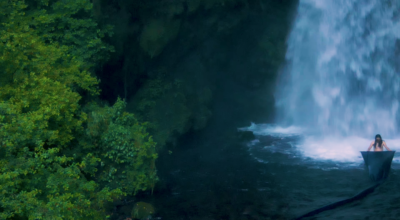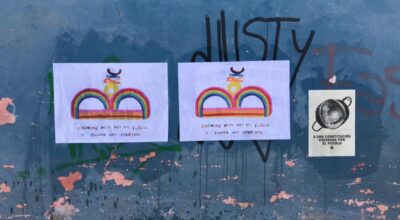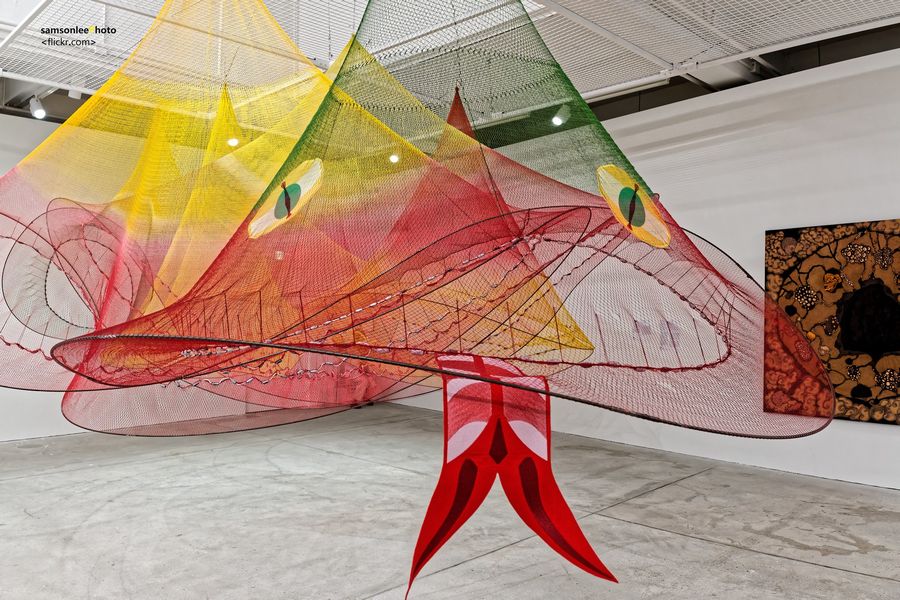
GREEN SNAKE: WOMEN-CENTERED ECOLOGIES
Green Snake: Women-centered ecologies focuses on the connections between art and larger themes of ecology in the context of rising temperatures and extreme weather events. Gathering more than 30 artists and collectives from 20 countries, the exhibition presents over 60 works that draw on mythologies and worldviews with women at their heart to explore possibilities for alternative ecological relationships and to imagineother futures.
Green Snake points to the extractive economies at the root of our ecological crises, economies that treat nature as a reserve of resources for exploitation. The exhibition asks what alternative narratives are activated through artists’ visions which celebrate nature as a generative force, many of them grounded in notions of care and interrelationship at the intersection of ecology and feminism. The labor of care is essential to the reproduction of existence: this has been undervalued in patriarchal and imperial systems across broad geographies.
The exhibition title refers both to the celebrated ancient Chinese folktale about two demon sisters, White Snake and Green Snake, and to mythological snake-like figures across cultures and cosmological systems— just as snakes shed skins and emerge from hibernation, nature has a remarkable capacity to transform and re-awaken.
In the eighth-century folktale Madame White Snake, the figure of Green Snake strongly represents women’s agency, sisterhood, and gender fluidity; the tale has been widely reinterpreted in contemporary literature and cinema. On another level, in the exhibition, the snake’s sinuous curves echo the geomorphology of river systems and the vital energy of the water flowing through them.
Several artists in the exhibition have longstanding research interests in specific river ecosystems and in their associated mythologies. Dialogues between works rooted in different geographies highlight parallel struggles and parallel practices of empathy and care for non-human existence. The figure of an all-encompassing circle of planetary and cosmic renewal emerges in a symphonic call for a radical reorientation of the human within the whole.

GREEN SNAKE: WOMEN-CENTERED ECOLOGIES
Kathryn Weir and Xue Tan
What does it mean for humans to dream of snakes? Across wide geographies, snakes carry powerful symbolic associations with nature’s capacity to shed skins, transform, hibernate, and re-awaken. Down through the ages, artists have enlivened the strange attraction of these fluid beings and their divine cosmological forms that reflect nature’s metamorphoses.
Powerful serpentine figures exist in mythologies across a multitude of cultures, from the Aztec feathered serpent god Quetzalcoatl, associated with the arts and learning, evoked by Maria Thereza Alves in her painted sculptural relief about resilient Indigenous deities in the area of Xico in Mexico, Still here (2023), to the double-headed serpent in Minhasan cosmology in Sulawesi, Rembet mi Wailan, a guardian figure between the seen and unseen worlds that artist Natasha Tontey brings to life as feminist pantomime in Of other tomorrows never known (2023). In Indigenous Newar culture of the Kathmandu Valley, as Karan Shrestha’s sculpture cloud babies (2023) envisions, snakes are celebrated as guardians of water.
Green Snake: Women-centered ecologies presents these and other works by artists who draw on and revitalize diverse cosmological systems in relation to ecology, as well as women-centered knowledge and experience.
Hong Kong artist Jaffa Lam restages the spiritual presence of Tin Hau, an influential female protector figure in the lore of Hong Kong and Southern China. Tin Hau, who lived in the tenth century, became revered as a goddess of the sea for guiding fisherpeople to safety.
In Hong Kong alone, there are over 100 temples dedicated to her, mostly situated near the shore. After witnessing the demolition of several Tin Hau temples to give way to land reclamation and redevelopment, Lam, who was born in the same city as Tin Hau in Fujian, imagined a new icon of workshop for the goddess that could float rather than being housed in a temple in her installation Tin Hau is coming for a piece of water 2.0 (2023): a volcanic rock from Fujian symbolically represents the goddess floating. Of the same weight as the artist, the rock gives substance to her feeling of connection to the deities’ strength across a millennium.
Folktales and mythology are thus brought to life again and rewritten. Women-oriented narratives, which speak to interrelationship and care, are being activated by artists to illuminate paths forward and embody alternative value systems. These narratives counteract the prevailing systems that have led the planet into a spiral of toxicity and extreme weather events.
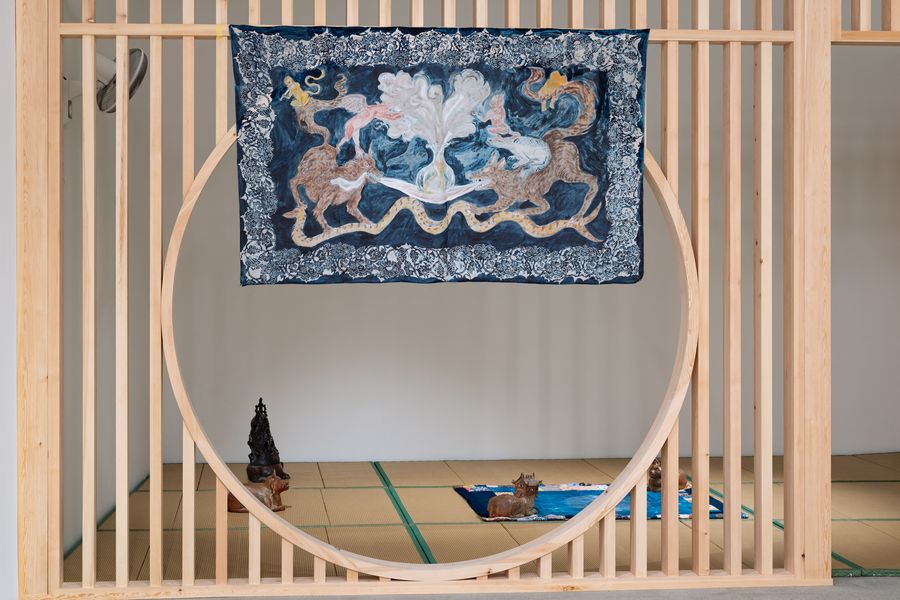

Another focus for artists in the exhibition is myths and stories centered on that which is more than human, placing humanity within an all-encompassing whole and questioning narratives that separate humans from nature.
In shared sensualities (2020-21) and valvala (2023), Karan Shrestha depicts connections between living and non-living beings in the worldviews of several Indigenous groups in Nepal, where the elements of water and earth are considered inseparable from humans and other animals.
While shared sensualities emphasizes connections to the land, the painting valvala references the arrival of the monsoon and water spirits, as well as ritual practices maintaining human relationships with water and other life forms.
Drawing on rich Indian miniature traditions, Manjot Kaur combines ancient stories and precarious ecologies with speculative visions of alternative relationships between deities, humans, and the environment, imagining hybrid beings inhabiting existing mythological narratives.
In her series Forest invoking the Ashta Mātrikās, it is the forest that invokes the protection of transformed deities: goddesses who have taken on the heads of the animals upon which they are traditionally shown riding.
Lost shadows by art collective Gidree Bawlee from northern Bangladesh centers on the spirits of lost beings that once inhabited the waterways near the village where the collective is based. The narrative of the shadow procession in the video, made together with a puppetry theatre group of mainly young girls, speaks of the Skukh, Dukh, Vulli and Pathraz rivers, bodies of water that are drying up due to intensive agricultural irrigation and made toxic through fertilizer and pesticide run-offs.
The spirits of the numerous varieties of fish and other aquatic life that once lived there are brought to life in the procession of fabled beings that were once part of the village community.


The exhibition entrance is through a temple that takes the form of a snake’s head yet also reflects in its patterned surface the microscopic organisms found in soil and the internal cellular structure of plant roots: Yussef Agbo-Ola and Tabita Rezaire’s MIKA: 8 Root Temple (2023) and walking meditation in the Prison Yard of Tai Kwun.
A temple of healing, MIKA is also inspired by the form of human lungs and plant anatomy. It honors the rhythms and forms shared between plants, microorganisms and humans, while also celebrating the inorganic geological time of rock and soil.
In the context of climbing global temperatures and spreading toxicity, Green Snake points to the extractive economies at the root of these crises that treat nature— including much of humanity—as reserves of resources to be exploited. Such economics of extraction have a long history that is intertwined with the history of settler-colonialism and imperialism.
The consequences have been devastating: the suppression of Indigenous and other non-capitalist cultures and knowledge systems, as well as the desolation of nature in the pursuit of limitless growth.
Today, the destructive effects of capitalism’s single-minded focus on profit and growth are more widely recognized. The impunity with which it has destroyed worlds and spread toxicity and pollution in its wake is now resulting in the collapse of ecosystems and vast extinctions of species, along with accelerating climate change.
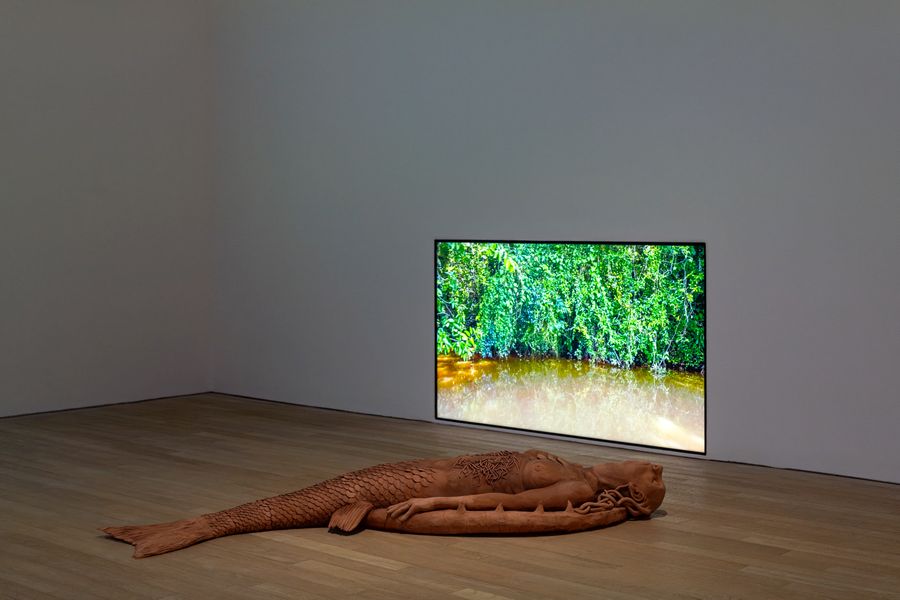
The exhibition presents works by artists who unfold in their practice the political history of these ecological crises and envision paths beyond the devastations of the modern period. By challenging accepted interpretations of history and the present, some reveal the ways in which present forms of knowledge have been constructed through violent processes that have been made to seem natural.
Adriana Bustos draws on historical images and maps associated with imperial oppression, and on anthropology, science, popular culture, fiction and biographical writings in her epic drawing Afluentes Sudamericanos: carta de navegación (South American tributaries: navigation chart) (2023), a visual narration of South America through its rivers, from a political and ecological perspective; she juxtaposes historical narrative elements with environmental disasters caused by the extraction of resources.
Artists Stephanie Comilang and Simon Speiser collaborated on the project Piña, why is the Sky Blue? (2021); “piña» means pineapple fiber in both Spanish and Tagalog, a key commodity traded through the Manila Galleon Trade Route established by the Spanish in the early 16th century. The two artists come from cultures at the two ends of this trade route—the Philippines and Ecuador—and were inspired by shamanic women healers in Palawan and by the feminist collective Cyber Amazonas in Ecuador to create Piña as an intelligence that transcends technological and physical boundaries and embodies ancestral knowledge and resilience.
Marzia Migliora’s Paradoxes of plenty #54, the snake ritual (2023) is part of an ongoing series, begun in 2015, that explores transformations in systems of production and consumption. Migliora’s fifty-four drawings to date investigate how industrial agriculture and intensive capitalist economic models in general have relentlessly exploited both human and nonhuman existence.
Paradoxes of plenty #54, the snake ritual also reflects on textile production, in relation to women’s labor, with images of factories that speak to the conditions of women textile workers today alongside images of millenarian cultural and technological systems. The title of Migliora’s work refers to Aby Warburg’s lecture on the Hopi snake ritual, which describes a rite in which intimacy with rattlesnakes and other reptiles produces rainfall and fecundity.
At another level, in the title Green Snake, the snake’s sinuous curves echo the geomorphology of river systems and the vital energy of the water flowing through them. Several artists in the exhibition have longstanding research interests in specific river ecosystems and bodies of water, as well as in their associated mythologies. Dialogues between works rooted in different geographies testify to parallel struggles and to parallel practices of empathy and care for non-human existence.
In the past decade, Chinese artist duo Cao Minghao & Chen Jianjun have worked with communities along the river system that extends from Chengdu to the Qinghai Plateau, from fisherpeople to farmers and herders. They have explored the history of Dujiangyan, a water management system constructed in 245 BCE by observing ecological principles to switch more water through the streams of the Mingjiang river into agricultural areas across much of Sichuan in dry seasons; it is one of the largest and oldest such systems still in use.
Today, Cao and Chen’s research-based work is focused on the upper reaches of this same water system in Tibet with communities adapting to dramatic desertification and erosion, but which are working to reseed grasslands and stabilize these processes.
In their works, Seba Calfuqueo makes poetically visible relationships between water politics, gender, and land in Chile revealing the ways in which indigenous Mapuche and queer people, as well as the natural world, have been dispossessed under colonial rule. They underline resilience and multigenerational knowledge transmission; water occupies a central place in the artist’s practice—both for its spiritual associations in Mapuche culture as well as for its symbolism of gender fluidity.
Palestinian artist Dima Srouji’s installation The red river, in which a suspended hand-blown red glass river flows across the exhibition space, refers to the Belus River, today known as the Na’aman River, reputedly the source of the sand used for the first production of glass objects.
The red glass evokes the changes in the water’s color due to pollution caused by nearby industry, including the military factory Rafael Advanced Defense Systems. The river has great cultural significance and important objects of ancient material culture have been found in archeological excavations nearby, including a glass figure of the goddess Astarte now held in the Victoria & Albert Museum in London.
The film Quipu Mapocho (2016-17), by Chilean poet and artist Cecilia Vicuña, pays homage to the Rio Mapocho through a series of rituals performed along its banks and in its waters, while also mourning the environmental pollution it has suffered and the violent political acts that it has witnessed.
In Lago de Chalco, Maria Thereza Alves documents the changing morphology of the lake over time: dried out in the early twentieth century by a Spanish settler in order to gain thousands of hectares of land for plantations and cattle, resulting in the death of many fish and birds and the complete disruption of a millennial agricultural system.
Subsequent removal of the water from an aquifer to supply water to Mexico City caused a depression to form in the lakebed, while rainwater began to accumulate, creating a new lake. Still here: Chalchiuhtlicue, Quetzalcoatl, Tlaloc and further complexities invokes three deities to attest to the capacity of Xico’s waters to rebel against the environmental degradation and to return.
The connections between ecosystems, communities, and geographies, as well as the ways in which Indigenous embodied knowledge and cosmologies can confront colonial legacies and the effects of capitalism’s environmental degradation, are encapsulated in the exhibition through works by the Colombian artist Carolina Caycedo.
Her suspended sculptures, known as Cosmotarrayas, are made of fishing nets sourced from local communities that she transforms. They serve as symbolic objects that represent the complex relationships between people, rivers, traditions, and cultures.
A cobra grande (2019), one of Caycedo’s largest Cosmotarrayas, consists of seven interconnected hand-dyed fishing nets, a musical instrument called a caxixi, metal rods, and embroidered elements. The sculpture recreates a fabled giant snake inhabiting the Amazon River basin, a mythological creature believed to shape waterways as it moves through the forest.
The giant cobra is also believed to cause mudslides and other disasters when angered by environmental destruction. Caycedo’s work offers a powerful image of this non-human environmental agent and asks how we can follow in its tracks to repair ongoing harms and cultivate other values of care and deep connection.

The exhibition asks what alternative narratives are activated through artists’ visions that celebrate nature as an all-encompassing and generative force, many of them grounded in notions of care and interrelationship at the intersection of ecology and feminism.
The labor of care, essential to the reproduction of existence, has been undervalued within patriarchal and imperial systems across diverse geographical regions, as has attention to energetic connections and healing processes.
A series of artists in Green Snake offer alternative visions of the human body in relation to broader energetic and cosmic relationships. Ann Leda Shapiro’s watercolors and cutouts, for instance, are meticulously built up of ink and graphite circles that echo the pin pricking of acupuncture practices as well as celestial constellations. Some of her works feature organs entwined with planetary bodies and nervous systems morphing into rivers, forming a landscape where the human body, the earthly body, and the cosmic body are entwined.
Guo Fengyi also explores interrelationship, energy and consciousness in her works that depict otherworldly forms and figures, blending human, plant, water, and mountain in ethereal shapes. With no formal art training, she practiced qigong and meditation for over two decades as part of her healing process for chronic illness, drawing her visions on long scrolls first in pen and later in ink.
The resulting mysterious beings feature visible circulatory systems, described by the artist as channels for energy, that flow like water courses and point to the connections between the body’s meridians, landscape, and cosmic energy.
Resonating with these approaches is that of Lhola Amira, who draws on spiritual practices from South African cultures to create spaces for healing that are connected to the earth, the ancestral and surrounding spirits, with an installation that the visitor enters by parting a beaded curtain to stand on a healing bed of salt and hear sounds of singing and the natural world. The work is part of a series of unique portals created for the cleansing of wounds, the honoring of ancestors and connections.
Minia Biabiany reflects on Guadeloupe’s natural and historical context, recognizing its landscape as charged with memories of colonial extraction and toxicity, but also as a site of resistance. Her film-poem evokes the sea as a space of ancestry through poetic imagery and sounds, asking how natural spaces shape the way that bodies perceive, imagine, and move.
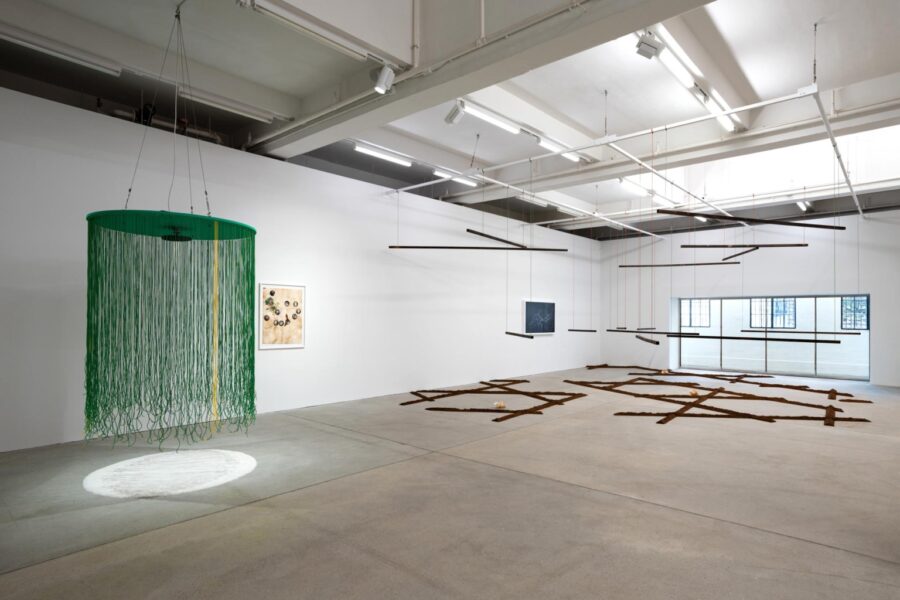

Art can transform the very images through which questions are asked and alternatives are sought, enabling, and empowering the speculative processes necessary to imagine other values and other worlds. Some artists look to existing but effaced narratives and images that call up other cosmological systems in relation to ecology and women-centered knowledge.
Dana Whabira’s recent research focuses on earth-healing practices that unfold an ethic of care and a symbiotic approach to organizing, living, and world-making. Her installation While women take shelter in the green space in their heads (2023), includes replicas of sculptures of vulvas believed to have been made by women and for women in ancient matrilineal societies existing prior to the 11th century in Zimbabwe. Additionally, the installation features four circular watercolors depicting a plant known as chikondepasi in Shona, which is used medicinally by women to stimulate breast milk production.
A sound component of the work features a conversation between Panashe Chigumadzi and Zoé Samudzi, who Whabira describes as “women who imagine and practice liberation in Zimbabwe, connected to the land, traversing realms of space, nature and politics”.
Lavanya Mani’s hand-dyed textile triptych No man’s land (2018–19) reveals a post-apocalyptic scenario in which clouds breathe fire onto a desert, while insects and surreal collaged species survive on the breast of the earth, suggesting the birth of new life in a post-human world. Her works Spore trails and Improbable planet (2018–19) trace cartographies of microorganisms that disperse and adapt across and within a ravaged planet. The iconography is inspired by the illustrations of the pre-Enlightenment German polymath Athanasius Kircher, whose Mundus Subterraneus posited the idea of a geocosmos, in which organic and inorganic worlds are interconnected.
Other artists in Green Snake imagine alternative narratives enabled by technology, biology or altered consciousness. In Genetic Drift: Symbiont III – Serpentes Parthenocissus (snake creeper), Rohini Devasher’s intertwined snake and plant elements creep across the internal skin of the exhibition space like an intelligent symbiotic biomass: a living system that is organizationally open and collectively produced.
It is inspired by genetic drift in evolutionary biology—random changes in the frequency of gene variants leading to mutations that may generate as-yet unknown, hybrid organisms. Nature’s deeply interconnected, resilient communities of hybrid beings often exceed human science’s explanatory systems.
Tricky Walsh’s The age of amnesia (2023), sculptural paintings including texts in English and Cantonese and augmented reality, presents a speculative story inspired by the theories of physicist Melvin M. Vopson. He has suggested that, at the current rate of information production, 350 years from now the number of digital bits on Earth will exceed the number of atoms.
The power required to sustain the conservation of digital information will exceed the total power consumption on the whole planet today. And 500 years from now, digital content will account for more than half the Earth’s mass. This data overload threatens to unbalance the Earth and change its orbit.
Yet Walsh posits that perhaps this critical overload could lead to a new state of consciousness called “Mutual Reception”, a spontaneous emergence of a state of empathy, where human beings become deeply linked and sensitive to other remaining life forms and existents.

The collaborative work of Valentina Desideri and Denise Ferreira da Silva centers on generating new vocabularies and systems for creating meaning through divination practices such as tarot and astrology, and through healing practices such as Reiki and political therapy.
Reading with Echo (2023) is part of an ongoing project to develop a new tarot deck. In Green Snake this revolves around four Major Arcana in the tarot that are women-centered: The High Priestess, The Empress, Strength, and Justice.
The artists reflected on the exhibition and “read” the individual works together with the curators to develop the tarot cards that are tools for new ways of thinking and experiencing the world—not as defining explanations but as open, speculative readings, contributing to nonviolent as well as generative ways of living on this planet.
Weaving together these artists’ visions to create a whole greater than the sum of individual parts, Green Snake: women-centered ecologies crystallizes the figure of an all-encompassing circle of planetary and cosmic renewal and stages a symphonic call for a radical reorientation of the human within the whole.

Green Snake: Women-centered ecologies is on view at Tai Kwun Contemporary, Hong Kong, until 1 April
Yussef Agbo-Ola & Tabita Rezaire, Tricky Walsh, Rohini Devasher, Ann Leda Shapiro, Guo Fengyi, Cecilia Vicuña, Gidree Bawlee, Karan Shrestha, Manjot Kaur, Dima Srouji, Adriana Bustos, Seba Calfuqueo, Maria Thereza Alves, Cao Minghao & Chen Jianjun, Jaffa Lam, Stephanie Comilang & Simon Speiser, Natasha Tontey, Candice Lin, Dana Whabira, Marzia Migliora, Lavanya Mani, Carolina Caycedo, Minia Biabiany, Lhola Amira, AFSAR (Asian Feminist Studio for Art and Research), Valentina Desideri & Denise Ferreira da Silva
También te puede interesar
SEBA CALFUQUEO: LA VOZ DEL RÍO
Basándose en las cosmovisiones indígenas de Sudamérica y en la injerencia de proyectos hidroeléctricos en los cauces, la artista narra historias de conexión y defensa de estos cuerpos de agua, trazando paralelos entre la...
LA INDIA CONTAMINADA. PRIMERA INDIVIDUAL DE CECILIA VICUÑA EN NUEVA YORK
Lehmann Maupin presenta hasta el 6 de julio "La India Contaminada", exposición con la que Cecilia Vicuña (Santiago de Chile, 1948) debuta en la galería neoyorquina. Esta representación de la obra de la artista...
LATINA POSTING: PAISAJES DISTINTOS Y PROBLEMAS COMUNES FRENTE AL ESCENARIO ACTUAL
Latina Posting es una red colaborativa que dispone y distribuye material gráfico para la circulación pública de ideas y pensamientos en distintas zonas de Chile. El eje de su primera intervención masiva es la...

